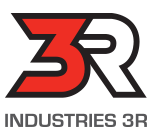PRICE QUOTE FORM - EXPANSION JOINTS
To obtain a quote for expansion joints, please fill the forms that suiits your application best. If you would like to talk to a sale representative about your application or have question on the form, please contact us at This email address is being protected from spambots. You need JavaScript enabled to view it..
Price quote form - Expansion joint
Molded expansion joint


 Molded elastomer seals are used for applications at lower temperatures. They have the advantage of dramatically reducing vibrations and noise. Their flexibility allows a large tolerance on different movement operations and facilitating the installation.
Molded elastomer seals are used for applications at lower temperatures. They have the advantage of dramatically reducing vibrations and noise. Their flexibility allows a large tolerance on different movement operations and facilitating the installation.
| Available materials | Min. temperature and operation limits | |
|---|---|---|
| Viton | -30 °C + 200 °C | -20 °F + 400 °F |
| EPDM | -40 °C + 120 °C | -40 °F + 250 °F |
| Silicone | -65 °C + 250 °C | -85 °F + 482 °F |
| Pure Gum (Natural) | -40 °C + 80 °C | -40 °F + 180 °F |
| Polyurethane | -50 °C + 100 °C | -58 °F + 212 °F |
| SBR | -25 °C + 85 °C | -10 °F + 185 °F |
| Neoprene | -30 °C + 100 °C | -22 °F + 212 °F |
| Nitrile | -30 °C + 85 °C | -20 °F + 185 °F |
Some of these rubbers are available FDA as well as reinforced.
Different mixes of rubbers may be used in the same expansion joint.
In order to permit us to fabricate the expansion compensator that will meet your needs, the following points must be valid:
- Inside dimension
- Joint width
- Wall thickness
- Temperature/li>
- Pressure (lb/in2)
- Vacuum (in Hg)
- Axial, radial mouvement
- External influence
- Chemical resistance
- Tolerance
- Quantity

Multi-layer expansion joint

These multi-layer expansion joints take up movement in several directions simultaneously; they have almost no reactive forces and need little space for installation. They quickly adapt to existing physical conditions and are easy to transport and install.
Different factors to consider when choosing a multi-layer expansion compensator:
- Movements
- Design / Operating Temperature
- Design / Operating Pressure
- Chemical Resistance
- UV Environment

Many combinations of products may be used to fabricate the multi-layer joints such as:
- Fluoroplastic membrane
- Elastomer
- Aluminium vapour barrier
- PTFE
- High temperature cloth (Fiberglass, Ceramic, Silica, etc.)
- Insulation (Ceramic, Glass mat, Silica mat)
- Stainless steel or inconel mesh
- Teflon impregnated fiberglass tape
- Etc…
The threads used in the conception of these joints are the following:
- Pure PTFE thread
- PTFE coated fiberglass thread
- Stainless steel reinforced Kevlar thread
Thermo-welded expansion joint
Industries 3R now offers thermo-welded expansion joints made from fluoroplastic membranes which possess a very high resistance to temperatures and aggressive products. We also offer you the opportunity to rent equipment in order to make your own seals on site. The choice of material for the manufacture of thermo-welded expansion compensators always depends on the application.
| Material | TEXLAM 1500 | TEXLAM 2000 |
|---|---|---|
| Temperature | ||
| Continuous | -40°C to 260 °C (-40°F to 500 °F) | -40°C to 260 °C (-40°F to 500 °F) |
| Short-time | 300 °C (572 °F) | 315 °C (600 °F) |
| Weight per square foot | 0,31 lb/ft2 | 0,42 lb/ft2 |
| Total thickness | 0,037 in | 0,047 in |

Movement possibilities

- Lateral
- Angular
- Axial (compression, extension)
- Torsion
The materials used and the methods of manufacturing are directly linked to various movement possibilities as well as variations in temperature operation and production downtime delays.
Expansion joints
Our wide variety of expansion joints are installed as flexible connections in air and flue gas pipes and duct systems to take up or compensate for thermal expansion, vibrations and misalignments. Depending on the application, the fabrics we use in their confection can resist to abrasions, chemical products and UV rays. Our expansion joints or expansion compensators are made to meet your particular applications.
Under the influence of more vigorous environmental standards on the control of pollutant emissions, the use of non-metallic gaskets ceases to evolve. To meet the industries needs, Industries 3R develops expansion joints made of rubber and of multi-layer canvas.


